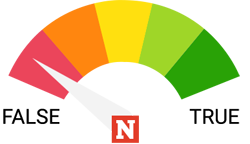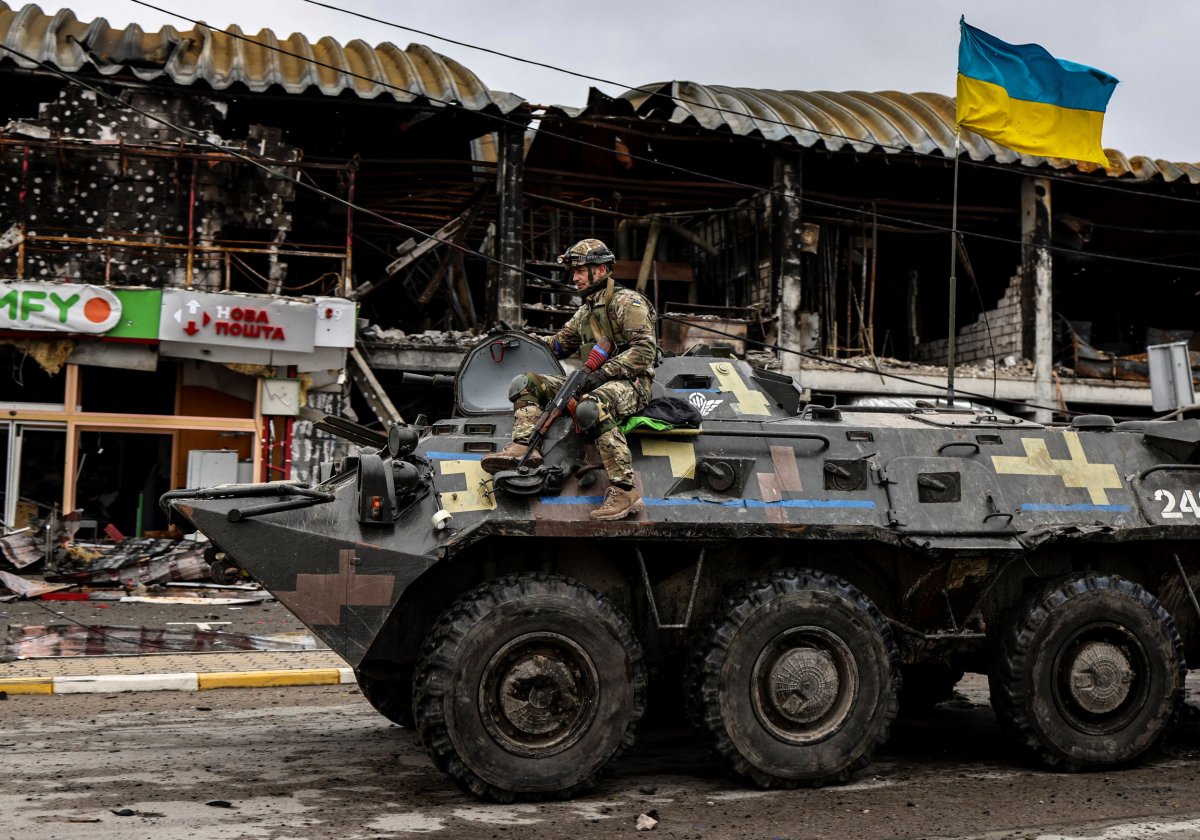As the world reacted in horror to images and videos of death and destruction left behind in parts of the Kyiv Region after Russian forces withdrew from those areas, Russian state media and officials issued a series of denials and counter-accusations, in some cases self-contradictory, that fueled disinformation surrounding the tragic events.
Ukraine's defense ministry alleged that civilians in Bucha and other towns and villages northwest of Kyiv were "executed arbitrarily," while it was occupied by Russian troops for several weeks. It claimed, attaching photos and videos from the scene, that some civilians were killed with their hands tied behind their backs and their bodies were left scattered in the streets.
More than 400 bodies of civilians have been recovered in the area so far, according to local officials.
The Claim
Russian state media outlets and government officials initially made no comment on the allegations that Moscow's forces were behind the devastation in parts of the Kyiv region over which the Ukrainian military regained control.
But on Sunday, April 3, a Russian Telegram channel called "War on Fakes," which spreads pro-Kremlin propaganda under the guise of "debunking" what it purports are false narratives about Russian atrocities in Ukraine, published a conspiracy theory claiming the massacre was "staged" by Ukrainian armed forces and foreign media outlets.
The Russian defense ministry, which at that stage had not yet issued an official comment on the allegations, reposted the article on its own Telegram channel.
Among the "evidence" used in the purported debunk are claims that a dead body can allegedly be seen "moving an arm," while another appears to "sit up" after the car with the camera operator passes by.
The same post also claims, seemingly in self-contradiction, that the Ukrainian Armed Forces shelled the town after Russian troops left, "which could also have resulted in civilian deaths." It shares a short clip, supposedly showing the aftermath of "Ukrainian shelling" of Bucha. The video features no actual footage of the shelling.
It goes on to say, without evidence, that a mass grave in Bucha was dug by the Ukrainian army because "they barricaded the town over a month ago, by blowing up a bridge near Irpen."
The suggestions that images and videos from Bucha are either fake, or staged, or both, then spread to other Russian-language channels, and were re-shared in English, German, Italian and other languages on Twitter and other social media channels.
Did you remember that Ukrainian psy oops fake story about bombing of Mariupol maternity house? This is a real story about that! Staged! Bucha massacre will be debunked soon as well - already in progress https://t.co/VcuPkzJYW2
— Igor Lopatonok (@lopatonok) April 4, 2022
Russian officials and media outlets, commenting on the events later on, presented a number of versions of what had occurred, including claims that Russian troops had withdrawn by the time the alleged massacre took place, that the bodies are in fact "actors" performing for "Western journalists," or that the massacre was actually carried out by Ukrainians themselves.
"The other day another fake attack was carried out in the city of Bucha in the Kiev region after the Russian servicemen left the area in accordance with the plans and agreements reached," said Sergei Lavrov, Russia's Foreign Minister, according to TASS, the state news agency. "A fake attack was staged there a few days later, and it's being fomented on all channels and social media by Ukrainian representatives and their Western patrons," the Russian Foreign Minister.
"This is the Yugoslavian scenario being played out," Vladimir Soloviev, one of the most prominent pro-Kremlin TV hosts, claimed without offering any evidence. "Soon they'll be accusing us of genocide. Bucha was never under full control, [as our troops left] a neonazi brigade entered and shot up the civilians."
The Facts
While it is difficult to establish an exact chronology of events in the lead up to the Russians' withdrawal from the area, evidence suggests that Russian forces exited the town sometime between March 31 and April 2, a few days after the Russian defense ministry announced it was "refocusing the special military operation" on the Donbass region and pulling troops out of the Kyiv region.
Posts from Ukrainian soldiers fighting to take back the occupied territories, including Bucha and Irpen, stated that a tentative ceasefire began on March 31, though the town council issued a warning on the morning of April 1 that it was not yet safe for civilians to return as there could still be Russian forces and parts of it could be boobytrapped with mines.
Videos published as early as the evening of April 1 show the Ukrainian forces clearing the town's streets, as they comment on the devastation around them. Newsweek reached out to the State Emergency Service of Ukraine for clarification of the timeline of events.
This footage appears to contradict the misleading narrative that the gap between the liberation of the region and the emergence of photo and video evidence proves the whole story was "staged" on April 2 by the Ukrainian military and/or members of the press.
#Ukraine Les Russes ont délaissé les villes du Nord et la capitale. Nos envoyés spéciaux l'ont constaté. Ils ont pris la route de Kiev jusqu'à l'aéroport d'Ostomel. Ils y ont découvert des villes ravagées...Un document exceptionnel.🎥@GuillaumeBrun20 @Laetitia_Simoes @jbbrunaud pic.twitter.com/79xIlftnRk
— M6info (@m6info) April 3, 2022
International journalists were allowed into the town on April 2, which is close to the time that the first visual reports of the atrocities began to emerge. Mikhailo Podolyak, an adviser to the Head of the Office of President Volodymyr Zelensky, shared some of the earliest images, as did Agence France Presse, Associated Press and other international news agencies.
Notably, the Russian defense ministry on Sunday April 3 claimed that its forces had fully withdrawn from Bucha by March 30. But just two days earlier, on the morning of April 1, it claimed to "maintain full control" of the Hostomel-Bucha-Ozera areas.
Newsweek reached out to the Russian Ministry of Defense for comment on the apparent incongruity, but has not heard back. But there are significant issues with the purported "evidence" of staging that the pro-Kremlin channels pointed to.
One claim, suggesting a dead victim's "arm appears to move" as the car moves past it, has been debunked by independent OSINT analysts, who point out that the movement is in fact a raindrop on the screen of the camera, as can be seen with an inverted channel version of the footage.
Getting fed up of this “it’s a moving arm” bullsh….. it’s a raindrop on the windscreen, alongside an inverted channel version for more clarity. The whole arm moving thing is just ridiculous. pic.twitter.com/ZiuEX4rFWc
— Aurora Intel (@AuroraIntel) April 3, 2022
Similarly, the claim that a body can be seen "rising" in a rear view mirror is just a trick of the eye: the curvature of the concave mirror acts to enlarge objects as they are reflected in it, as can be seen milliseconds later, with other objects also appearing to enlarge briefly.

Meanwhile, others pointed to a video of Ukrainian police moving through the streets of Bucha as evidence that in fact there were no dead bodies. The video cited was in fact published by the National Police of Ukraine on the evening of April 2, almost a day after some Ukrainian troops began entering the town and removing the dead, and at least 12 hours after the press was allowed in.
It is also quite clearly filmed in a different location, and thus cannot be used as "confirmation" that civilian remains were not present in other areas. The full version of the video features many local citizens greeting and thanking the Ukrainian forces for liberating the town, as well as recounting atrocities they observed under Russian occupation.
The claim that mass graves were dug up by the returning Ukrainian forces also do not stand up to scrutiny. A report by Reuters cites satellite images by Maxar Technologies showing the first signs of excavation for a mass grave at the Church of St. Andrew, where piles of bodies were discovered, as early as March 10, when the area was already under Russian control.
Finally, Russia's official line on the situation in Bucha, unlike Ukraine's version, appears unconvincing, relying on ever-evolving, unevidenced, and at times self-contradictory narratives.
The initial silence from Russian ministries and officials was followed by claims that the footage of atrocities in the towns abandoned by Russian forces are "fake," or staged, suggesting a conspiracy of a vast scale involving hundreds of troops, civilians and journalists, a highly unrealistic scenario.
It was then followed by claims that in fact it was a Ukrainian provocation, perhaps involving a mass murder by Ukrainians of "Russian collaborators," and eventually displaced by yet another variation suggesting the dead bodies are those of Russian soldiers.
These versions in some cases were posited almost simultaneously, with a top Russian U.N. diplomat on Sunday calling for an urgent U.N. Security Council meeting to address "the heinous provocation of Ukrainian radicals in Bucha," while the country's Foreign Minister stuck with the "fake attack" narrative just a day later.
In the light of heinous provocation of Ukrainian radicals in #Bucha Russia requested a meeting of UN #SecurityCouncil on Monday April 4
— Dmitry Polyanskiy (@Dpol_un) April 3, 2022
While no convincing evidence is being presented by the Russian side to support any of those versions, the method of obfuscation through dissemination of multiple narratives to plant a seed of doubt is a common tool of disinformation campaigns originating from Russia.
A notable recent example of such a "shifting narrative" relates to the downing of the MH17 flight over Eastern Ukraine in 2014, which Russia—despite overwhelming evidence that it is responsible—attributed, at various times, to Ukrainian artillery, a Ukrainian military jet and even a U.S. "psy-op" with hundreds of dead bodies stored on board of the downed aircraft.
Russia has also made a series of provably false claims about its actions in Ukraine, first claiming that it was amassing troops at the Ukraine border for "military exercises," and not to invade, and continuing to deny to this day that it has indeed invaded, calling its actions a "special military operation" to liberate the Donbass region.
The Ruling

False.
Ukrainian officials, dozens of international reporters on the ground and eyewitness have corroborated accounts of mass devastation and murdered civilians found in Bucha, a small town in the Kyiv region, after it was abandoned by Russian forces.
Russian denials have included a number of contradictory versions of events, including accusations that Ukrainian forces were to blame for the atrocities and that the whole incident was staged, but those claims, which have been amplified by social media accounts in several languages, do not stand up to scrutiny.
FACT CHECK BY NEWSWEEK

Uncommon Knowledge
Newsweek is committed to challenging conventional wisdom and finding connections in the search for common ground.
Newsweek is committed to challenging conventional wisdom and finding connections in the search for common ground.
About the writer
Yevgeny Kuklychev is Newsweek's London-based Senior Editor for Russia, Ukraine and Eastern Europe. He previously headed Newsweek's Misinformation Watch and ... Read more
To read how Newsweek uses AI as a newsroom tool, Click here.








